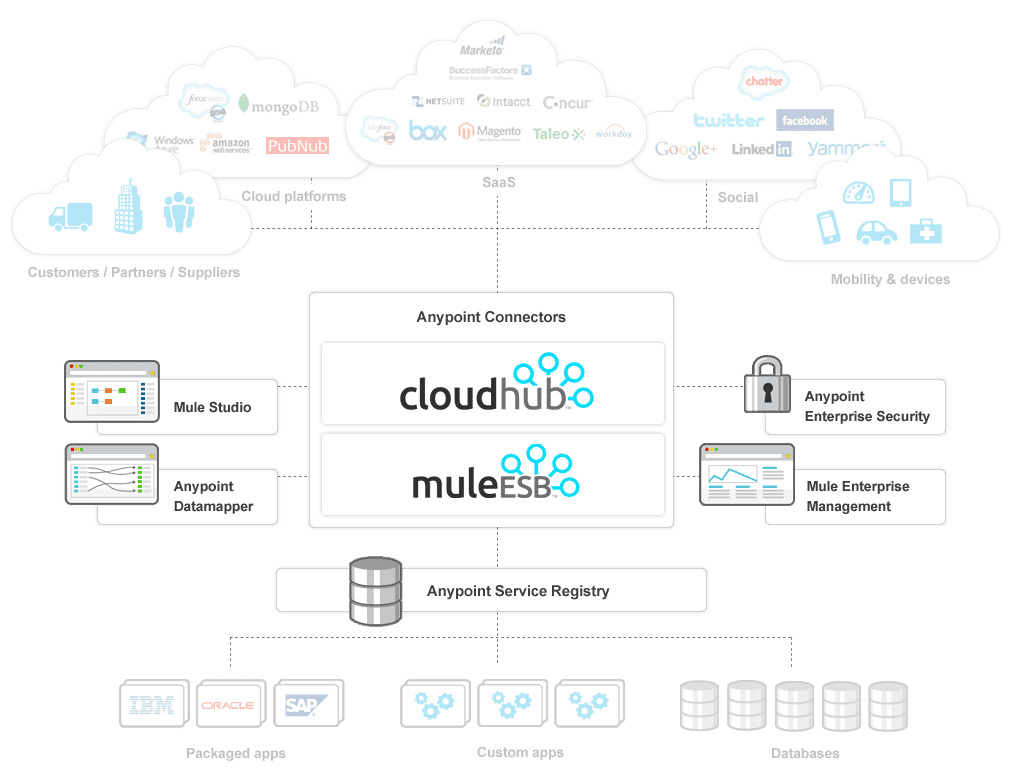Integration Across the Enterprise
As cloud computing takes over the IT landscape, the way organizations do business is changing. Cloud services and applications are on the rise, their popularity growing exponentially. Gartner estimates global spending on public cloud services will grow 17.7% each year through 20161. Moreover, with this boom in cloud computing, SaaS applications, and mobile devices, the enterprise is growing increasingly fragmented. No longer are organizations keeping their businesses grounded behind traditional walls. Instead, they are moving beyond their four walls and expanding into the cloud. To achieve the full potential of the cloud, organizations need to integrate their cloud applications each other and with data on premises.
Businesses are moving towards the cloud and employing more and more SaaS solutions, but still house critical data in on-premises databases and legacy systems. Organizations need a solution to help overcome the challenges of moving to the cloud and keeping the enterprise connected.
Integration-as-a-Service: What is it?
Integration as a Service (sometimes abbreviated as IaaS) is a cloud service delivery model for integration. Integration-as-a-Service delivers an integration solution that provides connectivity to backend systems, sources, files, and operational applications through the implementation of well-defined interfaces, web services, and calls between applications and data sources. This provides users with a more loosely coupled environment, safe from complex interdependencies. The Integration-as-a-Service delivery model enables integration across the cloud, making it possible to share data between systems as well as third-party vendors in real-time.
Businesses employ Integration-as-a-Service initiatives in order to gain agility and automate business processes. Moreover, with the change in the way the IT landscape is structured, businesses seek a flexible solution that is capable of delivering connectivity between databases, applications, files, and sources residing on-premises and in the cloud.
Point-to-Point Integration
Businesses have taken other approaches to ensure connectivity across the enterprise, including point-to-point integration. This approach calls upon experienced developers to build custom integrations between endpoints in order to allow seamless communication. Point-to-point integration, although appearing to be simple at first, quickly becomes complicated. As the number of applications, services, and systems increases, custom code integration becomes an intertwined web of connectivity, quickly becoming “spaghetti architecture”. This tightly coupled infrastructure creates dependencies that result in complications when changes need to be implemented. The fragile structure is vulnerable to breaking at even the slightest modifications. With inevitable change, businesses need to be flexible, scalable, and future-proof.
MuleSoft Offers the Leading iPaaS
MuleSoft provides businesses of all sizes the leading integration platform as a service (iPaaS). This platform approach to the traditional Integration-as-a-Service provides businesses with an end-to-end integration solution that orchestrates disparate components easily and efficiently.
CloudHub is the world’s leading cloud-based integration platform as a service that gives businesses the ability to integrate applications, systems, and services on-premises or in the cloud. It helps organizations stay connected through cloud to cloud and cloud to enterprise integration, as well as social and API enablement. The cloud-based solution also gives businesses flexibility and control to overcome the number one sales barrier that SaaS vendors face - integration. CloudHub, working with the other components of MuleSoft’s Anypoint Platform™, gives businesses all they need to stay connected in a highly fragmented ecosystem.
In addition a cloud-based integration platform, MuleSoft also offers an open source enterprise service bus to take the pain out of integration. Mule as an ESB is trusted by over 1,600 enterprise customers to support mission-critical apps in the most highly distributed environments to keep businesses connected both on-premises and in the cloud.
Both CloudHub and Mule as an ESB work with Anypoint Connectors to provide instant API connectivity to hundreds of popular applications and services, making it easy to integrate data across applications, systems, and services. Moreover, these pre-built solutions can be built once in Anypoint Studio, the Eclipse-based developer on-ramp. Anypoint Studio allows developers to quickly string together integration flows, implement orchestrations, and perform transformations, thereby accelerating development time.

Anypoint Platform works together to offer organizations a robust integration solution. More than just an Integration-as-a-Service product, Anypoint Platform provides a full set of solutions to help keep businesses connected. Learn more about all of the components of Anypoint Platform and how an integration platform can help connect your business by contacting an expert today.
1 Columbus, Louis. "Gartner Predicts Infrastructure Services Will Accelerate Cloud Computing Growth." Forbes. Forbes Magazine, 19 Feb. 2013. Web. 17 June 2013.



